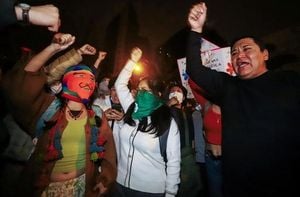As the chill of October sweeps across Ukraine, the country’s energy grid has come under a relentless barrage of Russian drone and missile strikes, triggering widespread blackouts, endangering nuclear safety, and prompting an urgent international response. Over the past week, Ukraine’s energy infrastructure has faced some of the most severe attacks since the war began, with President Volodymyr Zelenskyy revealing that Russia launched more than 3,100 drones, 92 missiles, and approximately 1,360 guided aerial bombs during this period alone, according to statements reported by multiple Ukrainian and international outlets.
On October 10, 2025, Russian forces unleashed a massive wave of drone and missile strikes targeting energy facilities across Ukraine, including Kyiv, Donetsk, Odesa, and Chernihiv oblasts. The aftermath was immediate and profound: at least 20 people in Kyiv were wounded, residential buildings suffered significant damage, and blackouts swept across large swathes of the country. Ukraine’s largest private energy company, DTEK, confirmed that the attacks left more than 800,000 residents in Kyiv without power overnight. The Russian Defence Ministry later acknowledged that it had used Kinzhal hypersonic missiles and drones, claiming the strikes were aimed at energy facilities supplying Ukraine’s military.
Despite the severity of the attacks, Ukrainian emergency crews worked tirelessly through the night and into the following day. By October 11, DTEK announced that main restoration work had been completed in Kyiv, with electricity restored to the vast majority of affected homes, though some localized outages persisted. Yet, the sense of relief was tempered by a new wave of strikes. On October 12, Russian forces struck an energy substation in Kyiv Oblast’s Boryspil district, injuring two DTEK employees and plunging nearly 10,000 households into darkness. Mykola Kalashnyk, head of the Kyiv Regional Military Administration, reported that both workers were hospitalized—one with shrapnel wounds to the head, chest, and limbs, and the other with an ear injury and abrasions. The attack, which occurred after the all-clear signal had been given, underscored the constant danger faced by those trying to keep Ukraine’s lights on.
“During restoration work in Kyiv Oblast, already after the all-clear signal, a team of energy workers came under attack. Two of our colleagues were injured,” DTEK said in a statement, as reported by The Kyiv Independent. Emergency teams raced to restore power, and “Points of Invincibility”—community centers offering warmth and connectivity—were opened to support residents left in the cold and dark.
The strikes are part of a broader Russian campaign to cripple Ukraine’s energy network as winter approaches. According to Ukraine’s Energy Ministry, emergency crews are working around the clock to repair damaged infrastructure and stabilize the electricity supply. The Ministry emphasized the urgency of these efforts, particularly as the country braces for freezing temperatures and the heightened risk of further attacks.
But the threat extends beyond conventional power plants and substations. The Zaporizhzhia nuclear power plant, Europe’s largest, has been in blackout mode for nearly three weeks as of October 12, raising alarm bells about nuclear safety. Ukrainian Foreign Minister Andriy Sybiha accused Russia of deliberately severing the plant’s connection to the Ukrainian power grid in order to test its integration with the Russian grid—an unprecedented move in the history of nuclear energy. “Zaporizhzhia NPP has been in blackout mode for almost three weeks, which poses a threat to nuclear safety. Russia deliberately severed the plant's connection to the Ukrainian power grid to forcefully test the connection to the Russian grid, an action that has never happened before in the history of nuclear power,” Sybiha stated, according to Liga.net.
Sybiha further alleged that Russia’s actions violate internationally recognized safety protocols, contradict the Ukrainian license, and directly threaten the possibility of a nuclear incident. He accused Moscow of occupying and seizing the Zaporizhzhia plant, deploying military personnel and weapons, mining its perimeter, and conducting technically unacceptable experiments. The International Atomic Energy Agency (IAEA) has recorded numerous attacks in the plant’s immediate vicinity, including on October 7, and has repeatedly called for restraint. On October 9, IAEA director general Rafael Grossi announced that the plant had begun the process of restoring external power supply after “frequent contacts” with both Ukraine and Russia.
The situation at Zaporizhzhia is especially precarious. The Ministry of Energy reported the tenth blackout at the facility since the beginning of the occupation, with the plant forced to rely on diesel generators not designed for prolonged use. “The generators and the plant itself are not designed for this,” the Deputy Minister of Energy noted, highlighting the risk of a catastrophic failure if normal power supply is not restored soon. Sybiha called on Russia to “stop shelling and repair the power lines immediately to prevent nuclear incidents.” He urged the international community and the IAEA to recognize Russia’s actions as “illegal, unacceptable and critically dangerous.”
International leaders have responded with a mix of condemnation and concrete action. On October 11, Canadian Prime Minister Mark Carney spoke with President Zelenskyy, expressing strong condemnation of the Russian attacks and pledging to coordinate closely with Ukraine to defend its energy infrastructure and ensure sufficient gas supplies as winter looms. The two leaders also discussed the International Coalition for the Return of Ukrainian Children and agreed to maintain close contact at upcoming G7 and international financial meetings to increase pressure on Moscow. Meanwhile, leaders from Britain, France, and Germany announced plans to use the value of frozen Russian assets to bolster Ukraine’s armed forces, a move designed to tighten the financial screws on President Vladimir Putin’s regime.
President Zelenskyy also reported a “very positive and productive” phone call with U.S. President Donald Trump on October 11, during which they discussed the latest Russian attacks and explored opportunities to strengthen Ukraine’s air defense systems. As the world watches, Ukraine’s government continues to call for greater international support—not just to repair the physical damage, but to deter future attacks and hold Russia accountable for what Ukrainian officials describe as deliberate attempts to undermine the country’s sovereignty and security.
As Ukrainians huddle in Points of Invincibility or anxiously monitor the Zaporizhzhia nuclear plant’s status, the stakes could hardly be higher. Each blackout is more than an inconvenience; it is a test of resilience, a threat to safety, and a rallying cry for international solidarity. The coming weeks will reveal whether the world’s response can match the urgency of Ukraine’s need.




